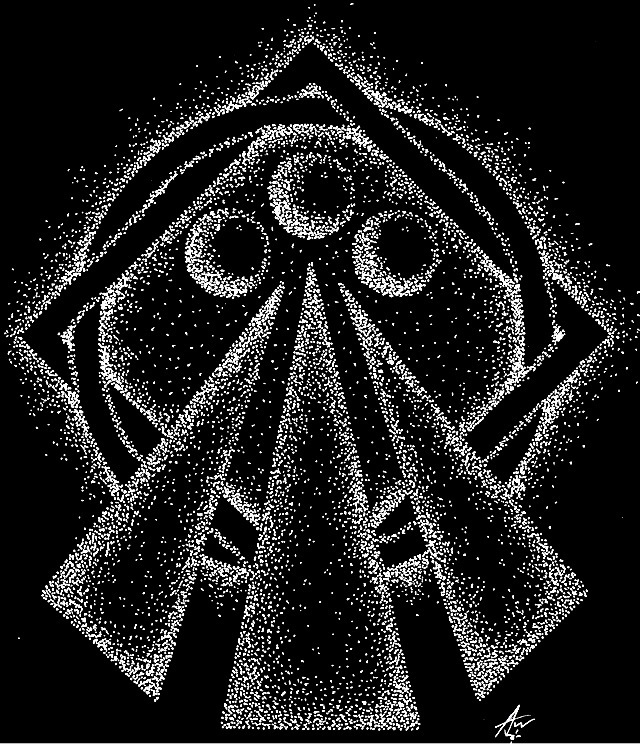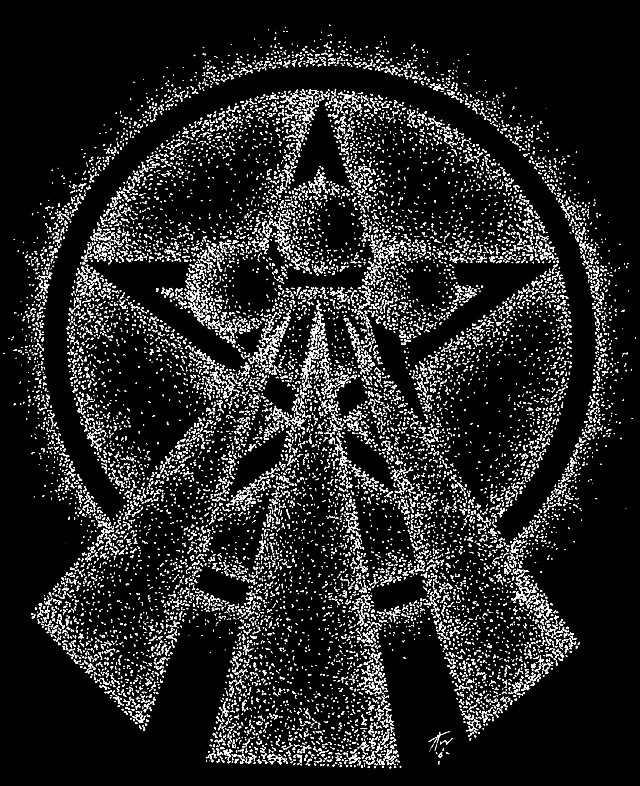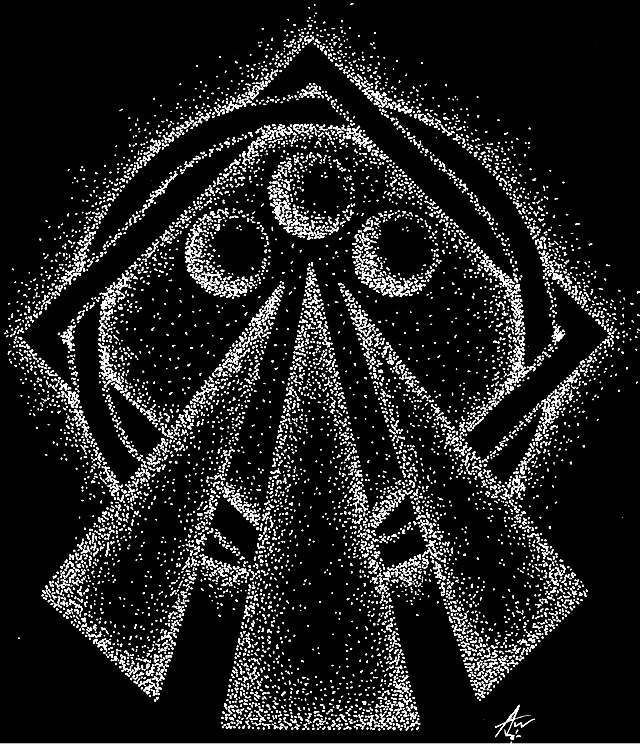The following article was written in 2009, and was first published in the 2009 December issue of ‘TOUCHSTONE’, the monthly news journal of the Order of Bards, Ovate and Druids.
Notes on Magick in the Druid ceremony
Introduction
Over the past year, when it has been my turn to host our monthly grove meetings, I have been presenting a series of talks, discussions and workshops on the subject of Magick. The following is extracted from August’s meeting. It is my intension to expand it into a much larger and in depth article to appear on our website soon.
The basic premise of the talk was the magickal aspect of the ‘Standard’ parts of OBOD ceremonies. If you look at the Orders 8 main seasonal festivals they can be split into 3 stages, an opening, a mid section and a closing. The opening and closing sections are fairly standard to all of the rituals, and as such can become ‘routine’ and be seen as something you just do to get to the mid-section or main part of the ceremony. But the opening and closing sections are full of extremely important magickal acts and techniques that are essential to the main ceremony.
In this shortened article I will skip over discussions of concepts and definitions of magick; Freemasonry; Hermetic’s and the Golden Dawn; etc.
Throughout the articles I use the term ‘Initiate’. This is gender neutral and signifies someone who has been initiated into the Druid mysteries; please feel free to read the word as Druid, Practitioner, Magician, Adept, Shaman, or other term you feel comfortable with.
The Opening Ceremony
The opening section of the ceremony is extremely important with two main functions; the magickal, psychic, and astral preparation of both the initiate and the working area, using a number of magickal, consciousness altering techniques.
At the Corieltauvi Grove, a standard ceremony would see us meeting at the ‘Hearth Grove’ site, catching-up etc, sort out who is doing what in the ceremony, then we robe-up, and prepare the circle with lanterns, incense, water etc. When the space is ready we gather outside the circle to the West, each standing a little way apart. Then one by one we approach the circle from the West, pause, walk sun wise (clockwise) to the East, salute, then find a place on the circumference of the circle, and give Peace to the Quarters. Next, the circle is cast, and depending on who is leading the ceremony, the intention is given at this point. The circle is then consecrated, and the Quarters are called. At this point we all move to the centre, join hands for the Druids prayer and chant ‘Awen’, move back to our places and into the main part of the ceremony.
This is all fairly standard and should be familiar to most of you, but now I wish to look at what is going on in greater detail. For the sake of brevity, I will also skip over sections on Robes and dressing the circle, and we’ll rejoin the action at the West of the circle, and look at what’s going on and what its magickal meaning…
Vigil in the West
The initiates wait out side of the circle, if possible to the west of the ritual area, here they separate and spend a few minutes by themselves mentally preparing for the ceremony.
This is the where the initiate consciously starts their psychic transformation, at this point the initiate should be calming their emotions and be beginning the consciousness shift from the mundane world to the magickal operation, preparing their light body/subtle energy body for the work ahead.
The Gateway and the Symbolic Sacred Journey
One at a time the initiates enter the ritual area/circle. They enter from the West pausing to acknowledge that they are entering a sacred space; they then walk clockwise around the circumference of the circle until they come to the East.
The western ‘gateway’ has many symbolic associations that will be working consciously and unconsciously on the initiate. The West is the direction of the element of water and the feminine and is often referred to as the ‘gateway to the soul’. Approaching from the West represents coming from untamed emotions and the land of feeling and reacting with out understanding, the West also represents the decline of the light, the period of fading understanding, the beginning of the end of an old cycle.
When the initiate pauses and acknowledges that they are entering a sacred space – it helps the process of altering the initiate’s state of consciousness from the mundane outside the circle to the spiritual inside the circle. They also acknowledge that they are starting a symbolic sacred journey around the circle and through states of consciousness.
The initiate walks clockwise/ sun wise to the East, symbolically they are passing from the mundane emotional, declining world (West), through the North, the land of death and rebirth, the embryonic stage of spiritual renewal, completing the subtle energy shift of consciousness.
The initiate stands before the East, pauses and salutes.
This marks the completion of the symbolic sacred journey. The initiate has passed through the land of rebirth and now stands in a ‘Golden Dawn’ of understanding and enlightenment. He/she pauses and salutes to acknowledge the ‘life giver’, the ’divine’. The initiate stands before the ‘all seeing light’; darkness is being dispelled, and clarity of understanding is beginning. The initiate has quit the declining path to be reborn into the Dawning light of understanding and an acknowledgement of the higher self and the higher principles.
“…Only in the presence of that degree of self-awareness and power of understanding which enables a man also to think what he experiences instead of just living it blindly. In the latter case he actually lives the myth and the symbol without knowing it.”
C.G.Jung
The journey West to East also helps to balance out the ‘Masculine’ (East) and ‘Feminine’ (West) energies both within the initiates and the sacred space.
Give peace at the Quarters
Peace is given and declared at the cardinal points (Quarters) in a set pattern: North, South, West and East.
This is an act of pure magickal evocation. The initiate is drawing up from an inner peace and projecting it outward (an inner peace made more complete and accessible by the symbolic sacred journey) this is done to dispel and calm astral turmoil around and inside the scared space. It is an aspect of psychically “cleaning” the space in preparation for the work to come.
Calling for peace/ calling the Quarters
Calling ‘Peace’ and calling the ‘Quarters’ is performed in a set pattern. Peace is called: North, South, West, and East; whilst the Quarters are called East, South, West, and North. This is done to represent two shapes, the cross and the circle, or the square and the circle. When I brought this up in our workshop meeting several reasons were put forwards including representations of the Celtic cross and echo’s of the Shamanic circle. I feel that that this order reinforces the symbolism of the Bardic grade symbol of the intertwined square and circle, with the circle representing spirit and the square representing the material world, intertwined because one cannot be complete with out the other. The circle and the cross is also the symbol of Malkuth, the 10th sephiroth (the kingdom) on the tree of life.
Cast the circle
The initiate in the East (in charge of the ceremony) psychically/ magically and physically/symbolically walks and draws the circle around the sacred space and the other initiates.
When the initiate casts or draws the circle they are delineating a sacred space on both the physical and astral/psychic planes. They are magically creating a place of focus and containment, a microcosm that they can control and affect; an area where they can still the swirling energies and create harmony and balance. It is a place of safety. Through their magickal will the initiates are psychically creating a working space that permeates all planes of existence, lighting up the astral planes.
The intention
The initiate in the East gives a brief welcome to the participants and dedicates the intention of the ceremony.
This is a simple act of bringing together the group will and focus.
Circle consecration
The initiates carry representations of Water and Fire around the circle often Laving or fuming the other participants as an act of blessing
Once the sacred space/circle has been established and the subtle energies and swirling forces have begun to be subdued and stilled the circle is consecrated with the representations of fire and water, an act that resonates on all of the planes. When consecrating with the elements the initiate starts by invoking the essence of the element into the symbolic representation of that element, transforming it from just a physical expression of that element to a magickal expression of that element in it’s purest form. The element is then used to ‘clean’ or bless the circle and the other participants. This act helps to balance the masculine and feminine energies with in the circle, cleans up any remaining unwanted energies and helps to purify the area and participants. Fire and water are both sacred to the goddess Brigit, the goddess of the Druids and Bards (amongst other things). In ancient times fire and water would have been the main ways of cleaning (washing in water, and fumigating fleas and lice etc).The elements combined also resonate with the concept of hearth, home and safety; they also link into the concept of the ritual/magickal sweat lodge that the Druids may have traditionally used.. Fire and water also represent the active aspects of feminine (water) and masculine (fire).
Calling the Quarters
The initiate moves to each cardinal point and ‘calls a Quarter’. The quarters are called East, South, West and North.
This is an act of magickal Invocation. Using authority derived from, by alignment with and reverence of the archetypal animal spirit that represent the character and essence of that Quarter. In the name of this ‘archetypal higher power’ the initiate summons or invokes the essence or subtle energies associated with and active through the chosen direction and elemental plane of existence. As the initiate invokes these forces he/she calls and awakens them, not only into the circle but also into themselves. By assuming a ¼ the initiate becomes an active and willing conduit to these subtle energies.
“And may the harmony of our lands be complete”
As each of the Quarters is invoked into the circle, the initiates and participants of the rite focus them into balance and harmony. The 4 subtle energies, or essences, are conjoined to create the 5th energy, that of spirit and the sacred. This 5th force is created both within the sacred space and the initiates/participants.
Druid prayer
All participants in the ceremony move forward and hold hands, forming a smaller inner circle. Then together recite the ‘Druid’s prayer’
This is a group devotional prayer act, which psychically draws the group focus together. It is also an act of invocation/evocation, and a part of the initiate’s mental / astral preparation. The Druid’s prayer is an appeal to the higher forces to share and expand greater mental states within the initiate once the inner scared has been cleansed and balanced
Call Awen
The participants, still holding hands to form a circle, chant or call the ‘Awen’.
This is an act of magickal invocation using an energy vibration technique. The initiates are invoking the concept of ‘Awen’ into themselves and into the circle – filling their cleared and balanced sacred inner and outer spaces with flowing spirit and inspiration.
Conclusion
So there you have it, the routine and standard ceremonial opening awash with magickal technique and symbolism; full of transformation, invocation, evocation, energy harmonizing and calming, individual and group focus, petitions to higher ideals and entities and a symbolic spiritual journey through the inner realms……. And all that before you start the main part of the ceremony!
The opening ceremony is an extremely complex and important part of the overall Druid ritual ceremony designed to magically clean, balance and prepare both the sacred space and the practitioner; and as with everything, the greater the conscious understanding and focus you have of it, the more effective it will become.





You must be logged in to post a comment.